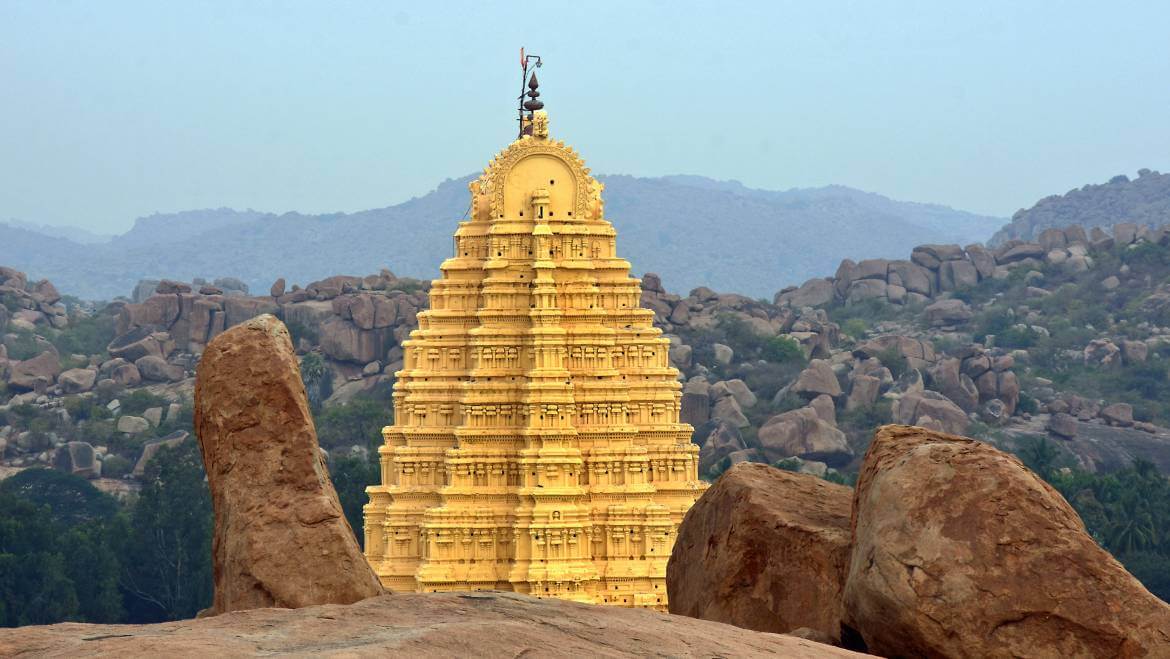Karnataka unequivocally is an important component of the old Indian culture and legacy. The state is home to some of India’s most notable and historic temples. Karnataka’s temples provide a unique window into the state’s diverse religious traditions, ranging from the elaborate carvings of Hoysala architecture to the calm atmosphere of Chalukyan shrines. These temples are not only important spiritual hubs, but they also beckon with their breathtaking architecture and exquisite craftsmanship. Some of them are cradled in utterly captivating settings such as gorgeous hills cloaked in mist, riverbanks, or busy towns.
With this blog, you will get a definitive list of the top 10 temples in Karnataka that are worth seeing, whittling down the vast assortment of highly regarded temples. Every temple we visit is a vivid example of how art, architecture, and faith can coexist together to create a story that seems to go on forever.
- Virupaksha Temple, Hampi
- Chennakesava Temple, Belur
- Hoysaleswara Temple, Halebidu
- Sri Sharadamba Temple, Sringeri
- Chamundeshwari Temple, Mysuru
- Murdeshwar Temple, Murdeshwar
- Dharmasthala Manjunatha Temple, Dharmasthala
- Kukke Subramanya Temple, Subramanya
- Udupi Sri Krishna Matha, Udupi
- Gavi Gangadhareshwara Temple, Bengaluru
Also Check Out: Popular Tour Packages for Karnataka
Virupaksha Temple, Hampi
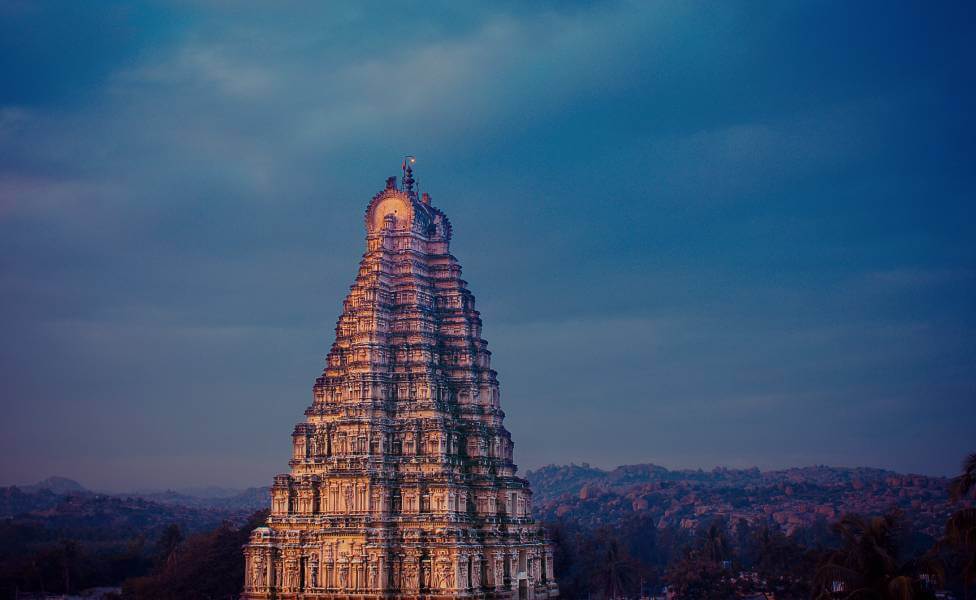
The part of the ancient Vijayanagar empire, Virupaksha temple is not only a popular Hindu temple in Karnataka but one of only a few living temples standing stagnant. Vijayanagar Empire, which also is considered among top richest empires ever existed, has exquisite architecture and beautiful murals throughout the temple. Not only the temple but the path to it is accompanied by many intriguing ancient collections of structures like Hampi Bazaar and Hampi archaeological ruins.
It is marvellous that this ancient temple is still one of the best pilgrimage sites to visit in Karnataka. It has various intriguing things like the three-headed idol of Nandi (Vahana of Lord Shiva), which is one of its only kind in the world, also the temple’s gopuram casts an inverted shadow at a point in the temple’s courtyard and the image falls on a wall through a small hole that acts as a pinhole camera and casts an inverted shadow of the temple.
Virupaksha temple has magnificent murals on the ceiling of the main shrine, which in some places is ruined by is still in excellent shape. Virupaksha temple, which is believed to have been built initially in the 7th century, had many additions and major ones in the 14th and 16th centuries. The fine work on all the corners of the Virupaksha Temple is unique and astonishing.
Chennakesava Temple, Belur
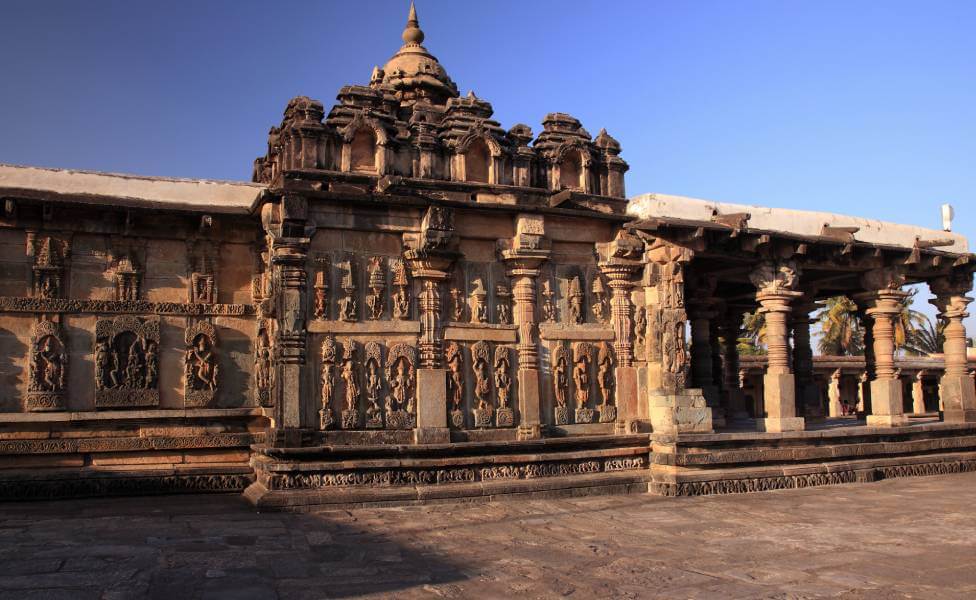
Imagine stepping into a 12th-century marvel, greeted by a sacred stepwell teeming with intricate elephant carvings. That’s the magic of Chennakesava Temple in Belur, Karnataka. Pushkarni, the stepwell at the entrance, sets the tone for a pilgrimage tourism through time and artistry. Built by King Vishnuvardhana in 1117 CE, this architectural gem is a testament to the Hoysala dynasty’s devotion. It took 103 years to complete, each inscription a whisper of the love poured into its creation. Situated on the banks of the Yagachi River, it stands as a survivor, having weathered attacks and plundering, only to be lovingly restored by the Vijayanagara kings.
As you walk around the temple, you will be witnessing one of the ancient and historical temples of Karnataka. The outer walls are a canvas of Mahabharata and Ramayana scenes, each animal carving whispering symbolic tales. Elephants symbolise strength and lions roar with courage. It’s a masterpiece where mythology and nature intertwine, leaving you breathless with its sheer detail.
Step inside, and prepare to be awestruck. Above every shrine doorway, intricate artwork brings Lord Vishnu to life. Whether it’s his cosmic dance as Nataraja or his serene repose as Ananta Padmanabha, the carvings are so lifelike, that you almost expect them to move. Look up, and intricate ceilings adorned with divine figures transport you to celestial realms. Photography is forbidden inside, perhaps a blessing in disguise. It forces you to truly see, to absorb the artistry with your own eyes, not through a lens. It’s an intimate experience, a conversation between you and the temple’s silent storytellers.
Chennakesava is significant for its temple history, spirituality, and architectural brilliance. It’s a love letter to Lord Vishnu, a testament to human devotion, and a whisper of a glorious era.
Hoysaleswara Temple, Halebidu
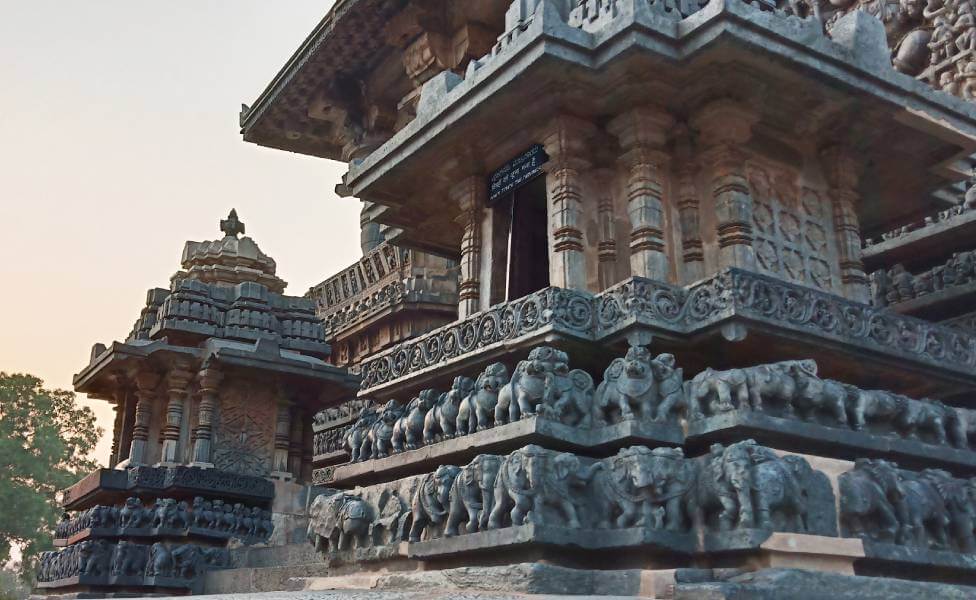
The 900-year-old Hoysaleswara temple emerges from the mist like a silent storyteller. As you approach, sunlight dances on its intricate carvings, each panel whispering tales of ancient India and the glorious Hoysala era. This monument transcends time and leaves you awestruck.
Built in the 12th century, this architectural marvel showcases the Dravidian tradition in all its glory. The temple boasts the classic Mantapa style, featuring a sanctum sanctorum and a grand Mandapa (hall) where devotees gather. It is one of South India’s top temples dedicated to Lord Shiva, and had its construction spanning a remarkable 30 years.
But the real magic lies in the details. Feast your eyes on the outer walls, a canvas teeming with stories etched in stone. Elephants march in procession, mythical creatures like the Yali guard the doorways, and scenes from the Ramayana and Mahabharata unfold in intricate panels. Look closer, and you’ll find delicate floral patterns. Inside the Garbhagriha (sanctum sanctorum), the stellar-shaped ceiling and zigzag walls create a continued light and shadow, constantly shifting throughout the day. A beautifully polished Nandi bull, carved from black granite, stands guard for Lord Shiva. The Mandapa is supported by four pillars that divide the space into nine sectors. Further, the intricately carved ceiling tells the artisans’ skill. Spot the Sun god, Ganesha, Shiva Parvati, and even the thousand-headed Ravana.
Halebidu, just 16 kilometres from Belur, is easily accessible. Also, don’t miss the chance to explore the town’s unique soapstone industry. Watch artisans transform this soft stone into beautiful artefacts, from decorative sculptures to practical hand-pounders.
Sri Sharadamba Temple, Sringeri
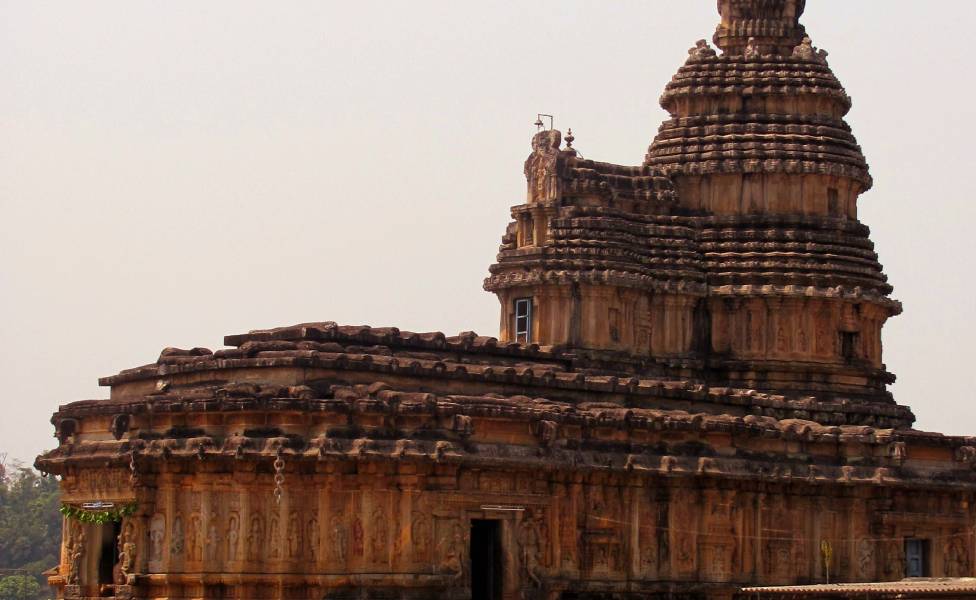
The Sri Sharadamba Temple, one of the holiest and most important Hindu Pilgrimage Sites in Karnataka’s Sringeri town. Sringeri is the location of the first of the four Peethas (centres), having been founded by the great philosopher Adi Shankaracharya, the originator of the Advaita philosophy. The goddess of wisdom and learning, Sharadamba, is honoured in this shrine. Goddess Sharade is linked to learning, knowledge, music, and the arts. The golden statue of Goddess Sharade, known for her unrivalled beauty, is kept in the shrine. There are further temples on the property dedicated to Hanuman (Anjaneya), Garuda, Mahalaya Brahma, Adi Shankaracharya, Kodandarama Swamy, and Torana Ganapathy.
At first, the sacred site had a sandalwood Sharada Murti above the Sri Chakra, carved on a stone by Sri Adi Shankara. Later, the current golden icon was installed in place of the sandalwood idol by Sri Bharati Krishna Tirtha. The current stone architecture was built by Sri Sacchidananda Shivabhinava Nrisimha Bharati, who was sanctified in May 1916 by Sri Chandrasekhara Bharati. The Shilpa Sastras of Tamilnadu are engraved with deities such as Devis, Dwarapalakas, Raja Rajeshwari, and Durga, adorning the stone columns of the Mahamandapam.
The shrine radiates grace and blessings, having been cleaned by Acharyas’s devotion. In 1999, Goddess Sharada received a one-crore rupee golden chariot dedicated by Jagadguru Shankaracharya Sri Bharati Tirtha Mahaswamigal. The sanctum’s entrance was enhanced with the installation of golden doors featuring Ashta Lakshmi figurines during Jagadguru’s birthday celebration. This increased its popularity to make it among most famous temples in Karnataka. During festival processions, two chariots composed of gold and silver are utilized within the temple precincts. Sri Sharada Shrine holds specific Pujas on certain days, especially on Vijaya Dashami during Navaratri, parents of small children come together for the “Aksharabhyasa” rite, asking Sri Sharadamba for his blessings on their children’s education.
Chamundeshwari Temple, Mysuru
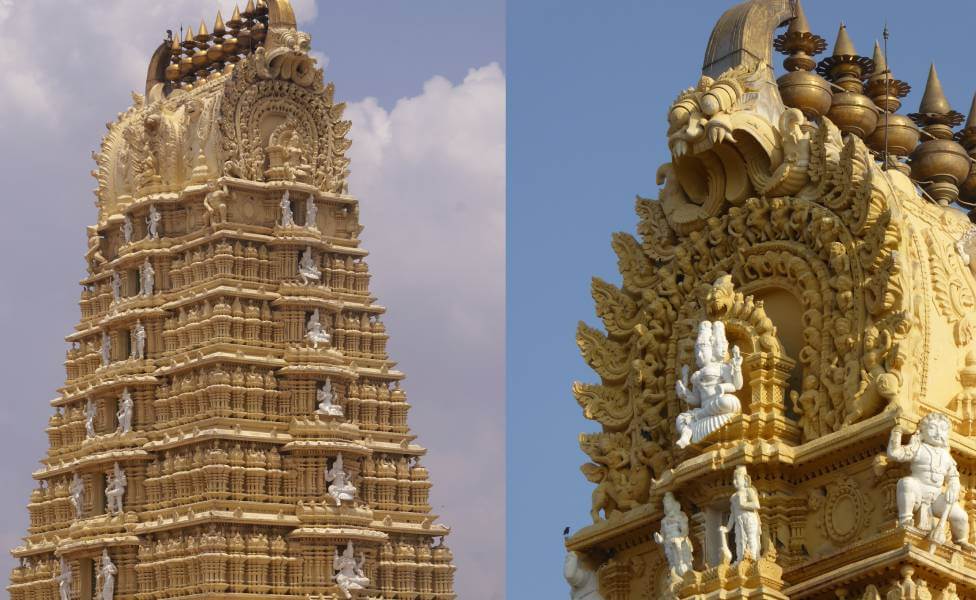
Perched atop the Chamundi Hills, the Chamundeshwari Temple in Mysuru, Karnataka is a majestic testament to Hindu faith and architectural brilliance. Dedicated to Goddess Chamundeshwari, a fierce incarnation of Shiva’s consort Parvati, this sacred site is steeped in legend and tradition.
Standing tall at 3,489 feet, the temple offers breathtaking vistas of Mysore city, including the iconic Lalitha Mahal Palace. Inside, the eight-armed idol of Goddess Chamundeshwari, seated on a lion and wielding a Trishul, exudes power and reverence. Imposing statues of Mahishasura, the demon she vanquished, and the Nandi Bull, Shiva’s vehicle, add to the temple’s mystique. Built over a millennium ago by the Hoysala rulers, the temple’s core structure exhibits the classic Dravidian style, characterized by a quadrangular layout with a gopuram (tower) and a dwara (entrance). Later additions by the Vijayanagar rulers in the 17th century, including the ornate seven-tiered gopuram, enrich the temple’s architectural tapestry. Legend has it that Sage Markandeya, author of the Markandeya Purana, established the revered idol in the sanctum sanctorum. The temple holds immense spiritual significance, particularly during Navratri when devotees throng its halls to celebrate the divine feminine. The amazing sight during this fesival lets you experience an overwhelming feeling of pilgrimage tourism in Karnataka.
Reaching this hilltop sanctuary is a journey in itself. You can choose to climb the 1008 steps, a 30-minute trek offering panoramic views, or take a direct bus ride from Mysore’s City Bus Stand. Chamundeshwari Temple is not just a spiritual haven; it’s also a beacon of environmental consciousness. The temple complex is a designated No Plastic Zone, highlighting its commitment to preserving the natural beauty of the Chamundi Hills.
Murdeshwar Temple, Murdeshwar
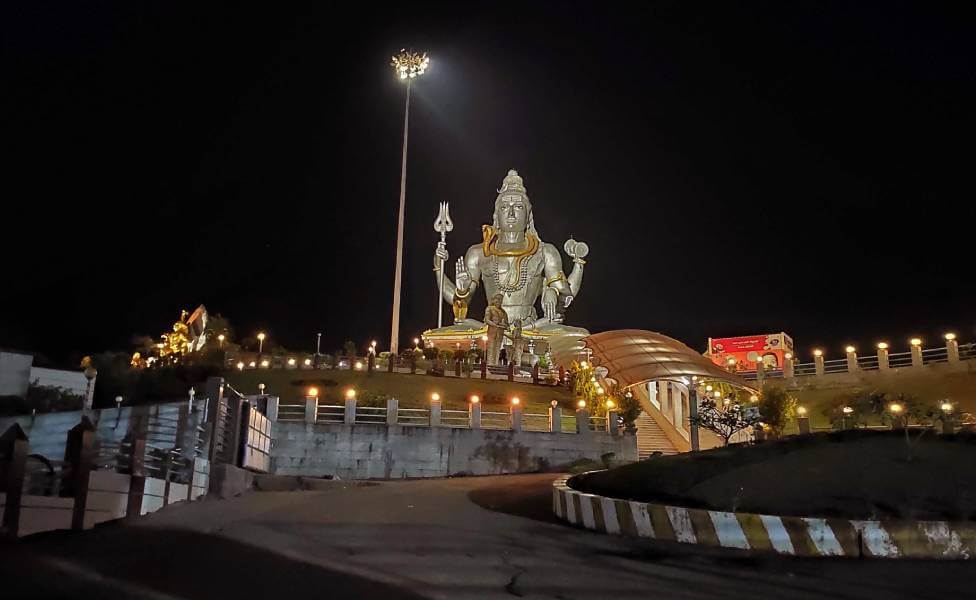
One of the most popular temples of Karnataka, the Murudeshwar Temple, is well-known throughout all of India, not just the state. The temple is devoted to Sri Mridesa Linga, a manifestation of Lord Shiva who is also referred to as Lord Murdeshwar. This temple, which is perched atop the sacred Kanduka Hills and encircled by the Arabian Sea on three sides, draws thousands of worshippers every day. The most notable feature of Murudeshwar is its 37-meter-tall, internationally renowned Shiva Statue, which is the second-tallest of its kind. In just two years, the entire temple complex—which includes the 75-metre-tall Raj Gopuram—was built.
The figure of Lord Shiva as Bhaghirnath, which depicts the sacred Ganga River descending, is noteworthy and enhances the attraction of the temple. The twenty-story Raj Gopura, which provides stunning panoramic views of the Murudeshwar Shiv Mandir, is one of Murudeshwar’s most distinctive features. The fame of the temple is further enhanced by the nighttime view of the Gopuram temple and the Shiva statue. The temple was erected by Chalukya and Kadamba sculptors and has a long history. It is fashioned in the classic South Indian Dravidian style. Two enormous concrete elephants that stand guard on either side of the Gopuram are notable additions. The entire complex has the essence of antique architecture, even though it looks modern.
Although the construction of the temple took several years, the enormous Gopuram was finished in 2008. This Gopuram’s construction started in 1990. An elevator that takes guests to the top floor of the Murudeshwar temple Gopuram offers expansive views of the town, the beach, and the fishing community. In addition to being a spiritual sanctuary, Murudeshwar is a well-liked travel destination for both residents and visitors. Long beach walks are enticing and enhance the temple experience, making it a complete and unforgettable trip for everyone.
Dharmasthala Manjunatha Temple, Dharmasthala
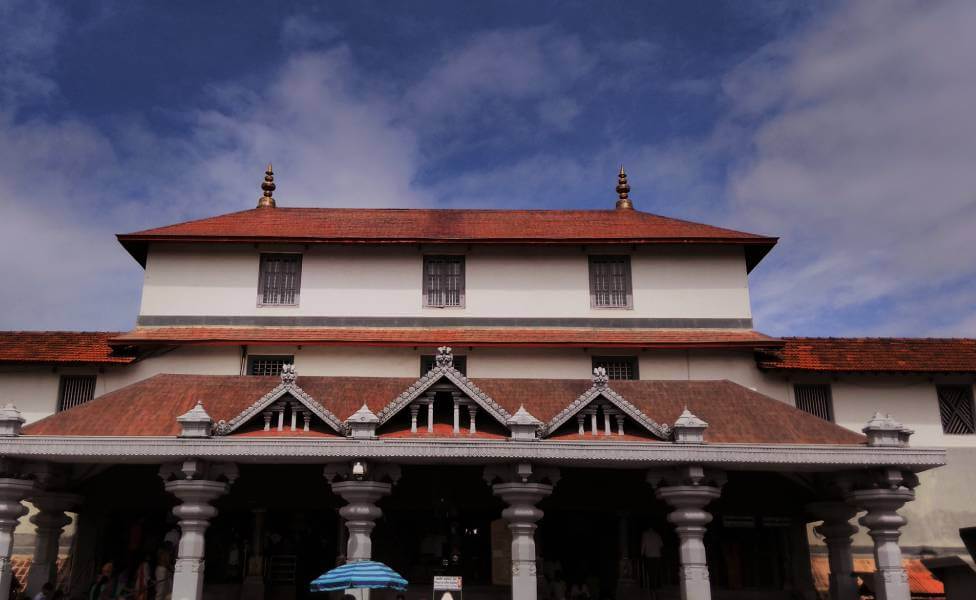
One of the holiest sites in South India is the Shri Dharmasthala temple, which is situated in the village of Dharmasthala in the Belthangady Taluk of South Kanara District, Karnataka State. The temple is well-known for its holy Dhams and beautiful environs. It is a treasure on the western ghats. Nearby is the river Nethravathi, where pilgrims frequently stop for a ceremonial bath before heading to the temple. This unique temple’s primary presiding deity is Manjunatha Swamy, who is joined by Goddess Parvathi Devi’s avatar, Ammanavaru. In contrast to other Shiva temples, Vaishnava priests perform daily rites for Lord Manjunatheshwara in Dharmasthala.
It is an unusual fusion of Hindu and Jain traditions, though, as Jains are in charge of the temple administration. A holy Kshetra, Dharmasthala draws pilgrims from all religions, including Muslims, Christians, Jains, and Hindus, who come to seek healing for their illnesses. This historic temple of Karnataka is where a Jain family was blessed centuries ago by the guardian angels of Dharmasthala. A significant occasion, the ‘Deepotsava’ festival takes place every year in November or December and involves the lighting of countless oil lamps all around the temple. Another notable feature of Dharmasthala is its unusual Chair of Justice, where the Judge is called Dharmadhikari.
The temple, a 16th-century masterpiece constructed by Sri Devaraja Heggade, is a testament to the ancient architecture of the Sapta-Konkana region. The original building was made of wood, laterite, and clay. Notable architectural characteristics of the temple include the three-story entryway with sloping roofs embellished with Kalases and the mukha mandap, or pavilion, in front supported by wooden pillars. The grounds of the temple are illuminated by almost 100,000 oil lamps during the Laksha Deepotsava festival, adding to the unique location’s meditative atmosphere.
Kukke Subramanya Temple, Subramanya
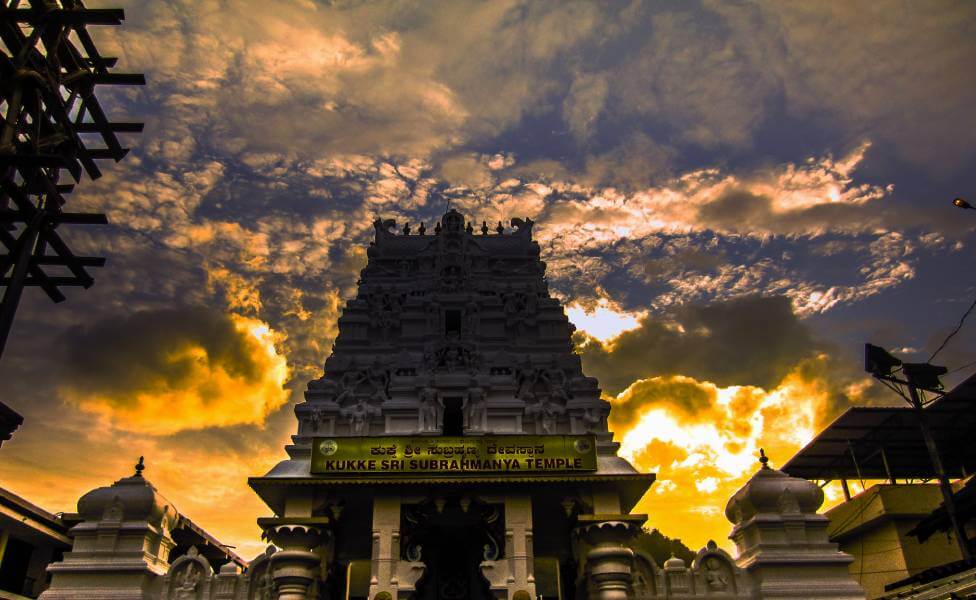
The Kukke Subramanya Temple is devoted to Subramanya, also known as Kartikeya or Shanmukha, the brother of Ganesha and the son of Shiva and Parvati. It is situated amid the immaculate surroundings of Subrahmanya in the Sullia Taluk of Dakshina Kannada. This hallowed location, known both historically and mythologically as “Nagaradhane,” is one of the seven sacred sites that Parashurama constructed. Living with Vasuki, God Subrahmanya, the ruling god of the Kshetra, is bestowing divine blessings onto followers in what is referred to as the “Guptha Kshetra.” Together with other Hindu gods and goddesses, Lord Subramanya sanctifies the temple, which is shrouded in mythology.
It is a stop on a pilgrimage circuit and is thought to be one of the seven temples in Karnataka, founded by Parashurama.
Special poojas and rituals like Sarpa Samskara, Sarpa Dosha, Ashlesha Bali Pooja, and others have made the Kukke Subramanya a famous Temple in Karnataka and around the world. Shiva Lingas, or Kukkelingas, were erected at Kukke by Celestial Sages; a group of these Lingas is visible inside the main temple. It is estimated that the current temple is more than 5,000 years old. Kukke Subramanya was formerly known as Kukke Pattana. The Gopuram, a typical Dravidian architectural structure, is located at the western entrance of the main temple, which is situated against the spectacular backdrop of Shesha Hill.
However, the eastern side is where the main temple entrance is located. A wooden chariot (Ratha) used during Maharathothsavam is visible close to the main Gopuram.
A silver-plated Garuda Sthamba is located in the outer courtyard, while the idol of the main sanctum is three stories high and features a five-headed cobra’s coiled hood that serves as a canopy over Kartikeya or Subrahmanya. Notably, a long list of well-known people, including Amitabh Bachchan and Raja Krishnamoorthi, have paid several visits to this revered shrine.
Udupi Sri Krishna Matha, Udupi
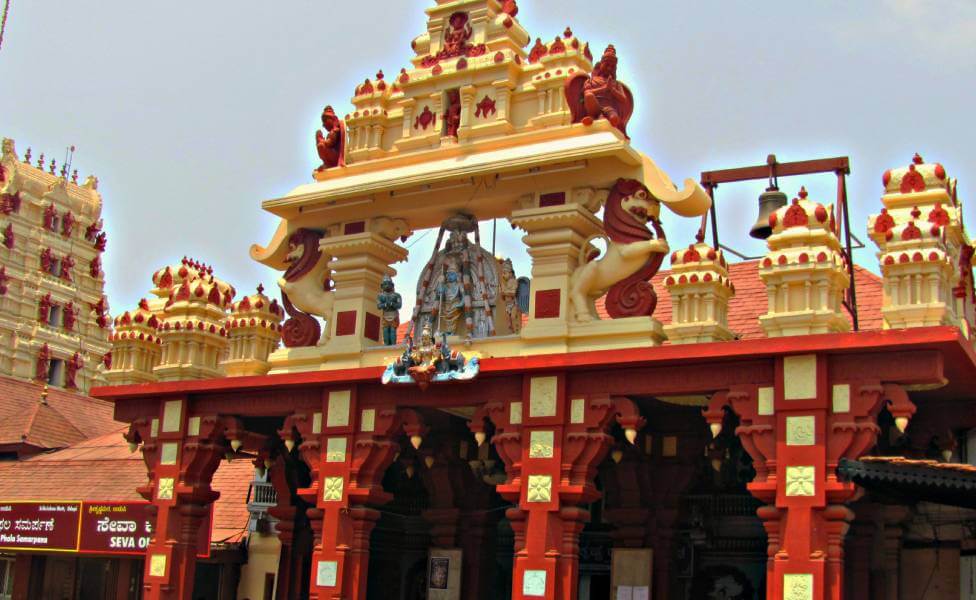
One of Karnataka’s seven holy religious tourism destinations in Karnataka, Udupi, also called Parashurama Srishti, is at the foot of the Western Ghats and the Arabian Sea. This seaside town, full of temples and rich in tradition, provides a special fusion of spiritual comfort and magnificent beauty. Unquestionably the most valuable site in Udupi is Sri Krishna Matha, also known as the “Second Mathura.” Founded by Madhvacharya in the 13th century, this magnificent temple complex houses the idol of Lord Krishna, which is thought to have been erected by Arjuna himself. The temple’s distinctive architecture, which has elaborate carvings and tall gopurams, is a tribute to the artistry of the time. The Navagraha Kitiki, a window with nine holes through which devotees offer prayers to the nine heavenly bodies, is what really distinguishes it, though.
There are rumours about a saint named Kanakadasa who was turned away because of his caste. His steadfast commitment did not wane, and he continued to pray through a gap in the wall. Lord Krishna turned, moved by his faith, and gave him darshan through a little window. The saint’s shrine, the Kanakadasa Mantapa, serves as a constant reminder of the strength of steadfast devotion. However, the allure of Udupi goes well beyond Krishna Matha, still, the importance of it cannot be unseen. Every two years, the Paryaya Utsava witnesses the eight Mathas ceremoniously give over control of the temple, setting off a colourful celebration that reverberates across the village. Moreover, the spiritual significance of Udupi extends beyond with other revered temples including, the Chandramoulishwar Temple, honouring Lord Shiva, which features an enchanting fusion of Hoysala and Dravidian design elements. A peaceful haven can be found at the Ananteshwar Temple, which has a pond and antique sculptures. Additionally, the Anegudde Vinayaka is a must visit temple in Karnataka for anyone hoping to receive blessings for a trouble-free voyage.
Gavi Gangadhareshwara Temple, Bengaluru
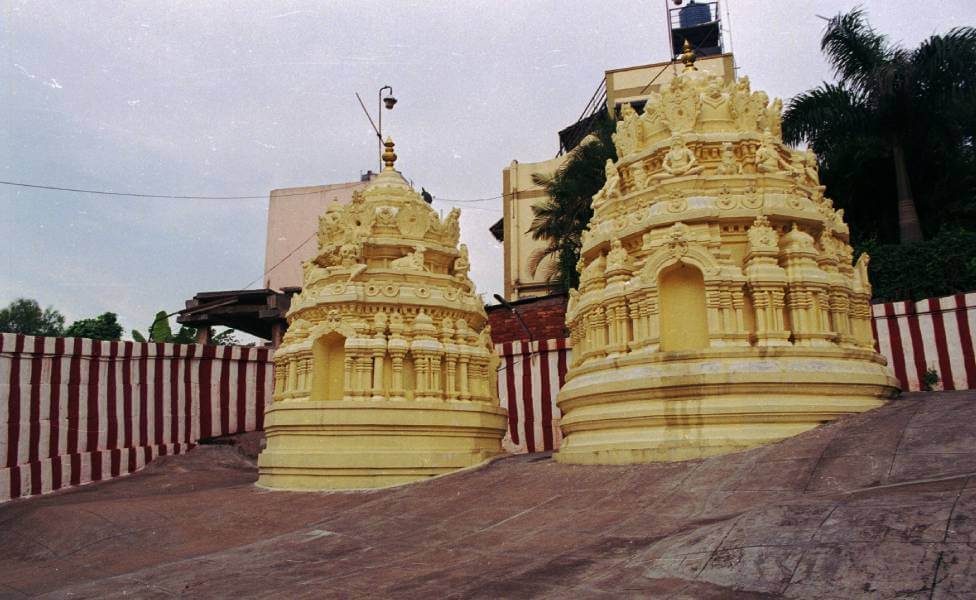
The Karnataka Ancient and Historical Monuments and Archaeological Sites and Remains Act of 1961 designates the Gavi Gangadhareshwara Temple, which is situated in a peaceful area in South Bangalore between Hanumanthanagar and Basavanagudi, as a protected monument. This cave temple, dedicated to Lord Shiva, is thought to have Chola origins and exhibits Indian rock-cut architecture. Known also as the Gavipuram Cave temple, it was constructed in the ninth century. There are distinctive features in the temple that are uncommon in South India. It is notable for housing an incredibly uncommon idol of Agni, the fire god, who has three legs, seven hands, and two heads. There is an idol of Shakti Ganapati with twelve hands and four monolithic pillars that stand in for Lord Shiva’s emblems, Dhamaru, Thrishula, and two fans. Lord Shiva’s mount Nandi is shown as a stone idol outside the sanctuary.
The temple’s wonders of architecture and astronomy are among its noteworthy qualities. The Shiva Linga’s feet and Lord Shiva’s body are momentarily illuminated by the setting sun as it passes through Nandi’s horns, which are positioned to coincide with Makar Sankranti. Despite the tiny size of the temple, live event broadcasts on television sets at the entrance are necessary due to the large number of devotees that attend this event. The shrine has a serene atmosphere despite its limited size. Inside the temple, visitors may often find themselves stooping, particularly to see the Sannadhi of Goddess Parvathi. Interesting facts regarding the temple’s architectural design are backed by scientific understanding and can be found on a placard near the entrance.
Other Interesting Blogs to Read
About the author
With a deep affection for places and their stories, Gulshan is a travel writer who brings destinations to life. His vivid narratives make readers feel as if they're experiencing these locales firsthand. Gulshan's straightforward yet detailed descriptions inspire a sense of curiosity and a desire to explore the world.

 +91-9212777225
+91-9212777225 Plan Your trip
Plan Your trip